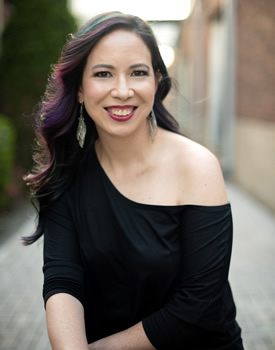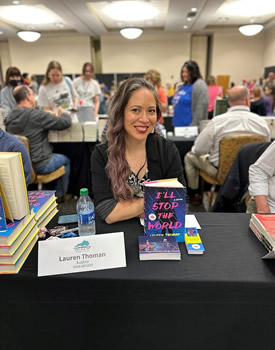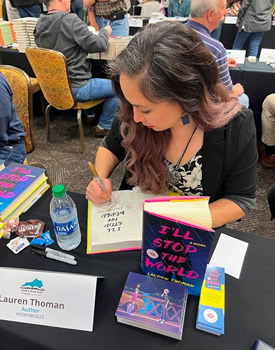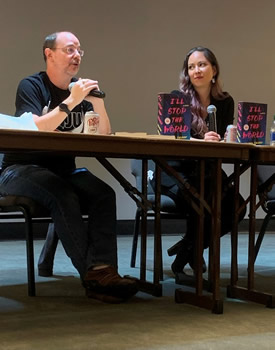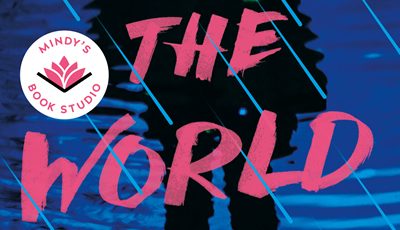

Features Up Close: Lauren Thoman
Exploring Important Topics Through Fiction and Art
 By Dawn Ius
By Dawn Ius
Lauren Thoman was certain her manuscript wouldn’t sell. Despite having a top notch agent, her previous projects hadn’t solicited a publishing offer—and so she wasn’t holding out much hope for I’LL STOP THE WORLD. Especially since the book served up a complicated structure.
But of course, the book did sell—as one of the first for actor Mindy Kaling’s imprint—and while the book has received well-earned praise, Thoman leaves the door open for a bit of confusion. It doesn’t last long. Once immersed in the story—two teenagers that go to the same school but are separated by a timespan of nearly 40 years—it becomes clear just what Thomas was trying to accomplish. And it’s brilliant.
In this immersive interview with The Big Thrill, Thoman takes a deep dive into how she created I’LL STOP THE WORLD and it’s characters.
Obviously the title of this book brought me back to the ‘80s—thanks for the ear worm!—but I was thrilled to find a whole ‘80s vibe throughout the book. I’d love to hear a bit about why you settled on that glorious time period for the “time travel” portion of the book.
I actually played around with a few different time periods for Justin to travel to (at one point, he was going to 1968 and getting sent off to fight in the Vietnam war, which would have been… a very different book), but ultimately, I realized that the ’80s made the most sense for a few reasons. First of all, I was alive during the ’80s, so I felt like I was more equipped to write it in a realistic way. It felt like a time period that would be far enough removed from Justin’s reality that he’d have to make some serious adjustments in order to get by, which I think is important for it to truly feel like time travel, but while still being recent enough to be able to draw clear parallels between then and now. And then of course, since Back to the Future was such an important inspiration for me, 1985—the year in which the first movie is set—seemed the natural fit.
It’s scary to say, but of course the ‘80s is considered historical—what were some of the challenges you faced while writing a dual timeline, perhaps beyond the obvious technical impediments?
First off, let me say that when I wrote the book, I honestly didn’t think it would sell, so I structured it in a way that is kind of undercut by the fact that it did sell and now there is marketing and a blurb on the back cover that reveals the basic premise. Which, obviously, has to exist now that it’s a book. But back when it was just a file on my computer, and I didn’t have to think about any of that, I actually designed the premise to be a bit of a reveal, where the reader is following several characters and wondering how these stories all come together, until suddenly, they do. That’s still how I think it’s best experienced, so if for some reason anyone is reading this interview and doesn’t know the premise of the book, maybe skip the rest of this, read the book, and then come back to finish the interview!
All that said, it’s funny, now that it is a book and most folks know the premise before reading a single word of what I wrote, a lot of readers assume they’re meant to be able to tell the dual timelines apart right away. But my intent when I was writing it was actually the opposite. I wanted to establish just how similar the teenage experience was in the ’80s to the teenage experience in the 2020s, before shifting to focus on the differences. I actually had the pilot episode of This Is Us in my head—remember that first hour of the show, back when we didn’t know how all of those characters were connected? And so all we had to focus on was the similarities of their experiences? That’s kind of what I was going for. So the first challenge was how to accomplish that without tipping my hand, while still being true to the respective eras. I was never trying to establish a distinct dual timeline; if anything, I was trying to smudge the lines between them enough that you didn’t even realize what you were looking at until you had the right perspective to bring it into focus. Like a Magic Eye poster (those were all the rage in the ’90s)!
Once we were firmly in the ’80s, though, the biggest challenge was just trying to think through what would feel natural to a modern teenager and what would throw him off. The rotary phone scene was actually inspired by a YouTube video a friend sent me of two teenage boys trying to figure out how to dial a number on a rotary phone. It fascinated me, because they were clearly smart and trying to problem solve using their understanding of how phones work today. And it was just not at all how phones worked back then. So I knew I had to put that in the book. I watched my own teenagers a lot, seeing how they interacted with their friends and environment, and thought back to the differences and similarities of how I interacted with my world as a teen in the ’90s. I did a lot of Googling to figure out when certain brands and styles and music were popular, just to make sure I wasn’t introducing anachronisms. I looked at headlines to remind myself what the big issues of the day would have been, and what these characters might have been aware of and thinking about. But honestly, it wasn’t as big of a challenge as one might think. I was always focused on the emotional journeys of the characters above all else, and I think that even though everything else changes a lot over time, the emotional experience of being a kid, or a teenager, or a parent has remained pretty similar from one decade to the next.
In I’LL STOP THE WORLD, we are introduced to a large cast of characters, but primarily Justin Warren and Rose Yin—two teens that attend the same school but are separated by almost 40 years of time. I was struck by how fully fleshed out each of these characters were. Can you share a little about the inspiration for each of them? Who was more difficult to write and why?
Justin was the first character I created for this story, and he came the easiest. The basic inspiration for him was Marty McFly without Doc Brown. But instead of just having a hair-trigger temper like Marty, I felt that giving him a diagnosed but mostly untreated mental illness that he was aware of but unequipped to really address felt more in sync to what a lot of teenagers today have to face. He’s a smart kid—if any of his teachers bothered testing him, which they probably never did, he likely would have tested as intellectually gifted—but with serious ADHD, which is an executive function disorder. He’s done some Googling; he knows what it means. He even explains it to Rose at one point. But the medication is expensive, therapy is even more expensive, and educational intervention like an IEP or a 504 plan require a lot of parental advocacy, which he doesn’t have, so he’s never received the treatment or educational accommodations he really needed in order to thrive. All of those things are things I am well acquainted with in my own family and my own personal experience, and I’ve known a lot of other kids and adults who had similar experiences.
So I wanted to show first of all, what it can look like to have a kid who’s had the deck stacked against him his whole life through no fault of his own, and what that has done to his own self-image. He thinks of himself as a failure, and someone totally lacking in potential, and the adults in his life have only ever reinforced that perception. He doesn’t push himself because he doesn’t see any point to it. But he’s always had peers that saw him differently. Alyssa and Rose both see him more clearly than he sees himself, which can be both a blessing and a curse. We see him at his best and his worst with both of them, because they’re the only ones who believe in him, but therefore, also the only ones he can still disappoint. That’s a lot for him to process, and he doesn’t always do it in a healthy way. I think that’s a long way of saying that with Justin, I sort of built him from the inside out, and he came naturally to me because his struggles were very familiar to me. I feel like I know this kid, and know both his capacity to hurt himself and others, and his capacity to be kind and caring and introspective and brave. All of that always exists inside him, always sort of tumbling around, and how he acts is an extension of what his brain is letting him believe at the time.
Then with Rose, I needed someone to be the anti-Justin. Someone with maybe a little too much executive function. Someone who over-considers, over-analyzes, and who is almost frustratingly unflinching in her ability to see the bright side and possibility in everything. It became clear very early on that Justin needed someone to play off of in whatever time period I sent him to, and it needed to be someone who would be relentless in pushing him when his instinct was to give up. Rose actually wound up looking a lot like I did in high school. Our families and interests are very different, but personality-wise, she’s very much who I was, especially in her ability to believe the absolute best of everyone she cares about, while being overly hard on herself. So that made her both easy and difficult to write, because obviously I am very familiar with myself, but really helping her shine meant letting her say and do the things I never allowed myself to even consider at her age. I revised her arc numerous times having to infuse her with the agency I didn’t feel like I had at her age. Writing her was kind of like a form of therapy for me, and anyone who’s ever been to therapy knows that working on yourself is the hardest type of work.
Time travel is hard! While personally I tend not to get too wrapped up in the science of it and just enjoy the ride, I know some readers can’t. I think you handled this so well and I’d be interested in hearing how you navigated the options for creating a time travel situation. I don’t want to give spoilers so please be as vague as necessary.
I adore time travel. I absolutely devour time travel stories of all types, always have, and I love both the overly science-y time travel and the time travel that leaves all the mechanics to your imagination. But when I thought about writing my own time travel story, I had to think a lot about which elements of time travel appealed to me the most, and what I personally wanted to say through the device of time travel. And for me, the why of time travel, and the philosophical questions about how we interact with a time period outside of the one we naturally inhabit, are always more interesting than the how of time travel. Plus, not being a quantum physicist myself, I didn’t really want to get bogged down in trying to convincingly explain the science behind a thing that actual real-life scientists have still not figured out. So instead, what felt the most interesting to me was to really lean into the impact of the time travel over the mechanics of it. Justin and Rose throw around all sorts of theories throughout the book, just like I think any of us would. But for me, I felt that forcing them to function within that uncertainty led to a much more interesting story than providing them with certainty. I realized I wasn’t interested in handing out answers, but I loved asking questions.
There is certainly a mystery at the core of this book, and it’s a great read, but you also touch on important and timely themes—love, redemption, sacrifice, racism and sexual identity. Aside from a satisfying read, what do you hope young readers will take away from this story?
I think that all artists are saying something when they create, no matter what their medium: books, movies, television, visual art, music. I think that’s the reason why we create art. It’s always about expressing ideas, asking questions, highlighting something important to the artist, evoking an emotional reaction in the person experiencing the art. I think in my writing, I’m always hoping to cultivate curiosity in the reader. I believe that curiosity naturally leads to empathy and compassion. It’s the impulse to want to learn and understand more. I think we live in a world where so many people are increasingly more certain, which is the opposite of curious. I have strong convictions, of course; I think anyone who reads my writing or follows me for two minutes on social media will see that clearly. But I try to remain curious. It occurred to me a while ago that if no one can be right about everything, then we are all wrong about something, and none of us knows what we are wrong about. If we knew, we’d change our minds. It’s humbling to think that there’s something—probably a lot of things—that I think I’m right about, but I’m not. So I try to always remain open to new information, and be willing to adjust my position accordingly. That’s really what learning is; it’s changing the way we think based on new information. Being curious is to be open to constantly learning and seeking out new information; being certain is to close ourselves off to it. I used I’LL STOP THE WORLD to explore a lot of topics that I have personally learned a lot about in recent years, in the hopes that maybe it would prompt others toward curiosity about similar issues. And through curiosity, of course, compassion and empathy. I’m still learning all the time. I hope I never stop.
Your book was one of the first to be chosen for Mindy Kaling’s Book Studio—what does being selected for this buzz-worthy imprint mean to you? Can you share a little about how this came about?
I’m still a little baffled about that, to be honest. All credit goes to my fantastic agent, Holly Root, who took me on years ago and never gave up hope despite so many projects not selling. She told me Mindy Kaling was starting a new imprint, and that she wasn’t sure what it would look like because no acquisitions had been announced yet, but that she knew one of the acquiring editors, Megha Parekh, and thought that she would enjoy I’LL STOP THE WORLD. I still was pretty sure it wouldn’t sell—and then, lo and behold, Megha and Mindy wanted it. I was absolutely floored when she brought me their offer.
I’m just so honored that Mindy selected my book to be the first debut for her studio. Obviously, it’s amazing to have a celebrity’s name attached to my book, and to have all the buzz that comes with it. I’ve been a fan of Mindy’s since her Office days, and to have her endorsing my work means so much. But through my conversations and experiences with Megha and everyone else at Mindy’s Book Studio, it’s been clear that Mindy and her entire team are really committed to giving marginalized creators every opportunity not just to publish a book, but to publish successfully. It’s not just having a team that prioritizes diversity and understands the barriers that women, and especially women of color, face in general and especially in publishing. It’s not just having editors who understand that writing a book with a diverse cast that engages with the issues marginalized communities face does not have to mean that the book is necessarily about diversity, and that diverse books can (and should) exist within any genre. All of that is amazing. But the team at Mindy’s Book Studio has also just put a whole lot of effort into giving my book the best possible chance at doing well once it’s published. They’ve set me up with a fantastic publicity team, produced an incredible audiobook, designed a beautiful physical book, hustled to set up appearance opportunities for me, and just poured so much work into giving this book the best possible chance at finding its audience. I’ve known far too many authors who wrote wonderful books who never managed to find their audience, because their publisher didn’t do much to support them. That has not been my experience at all. I feel so supported as an author, and that support has given me the energy and resources I need to keep creating. I wish that all authors, and especially authors from marginalized backgrounds, had that type of support. I hope that someday it’s the norm, not the exception.
- Africa Scene: Iris Mwanza by Michael Sears - December 16, 2024
- Late Checkout by Alan Orloff (VIDEO) - December 11, 2024
- Jack Stewart with Millie Naylor Hast (VIDEO) - December 11, 2024

